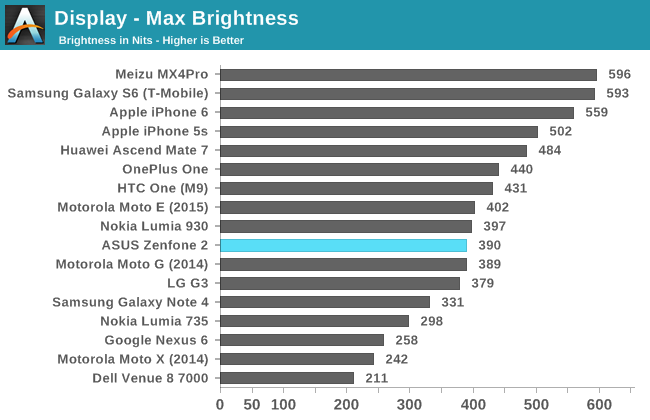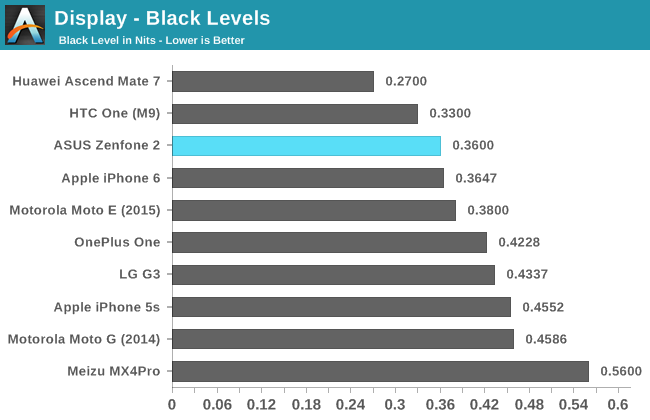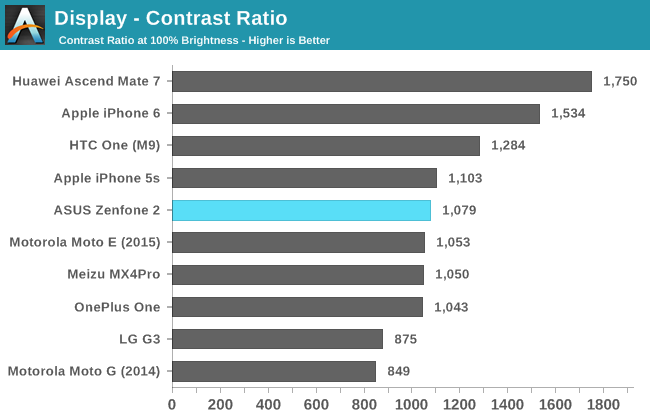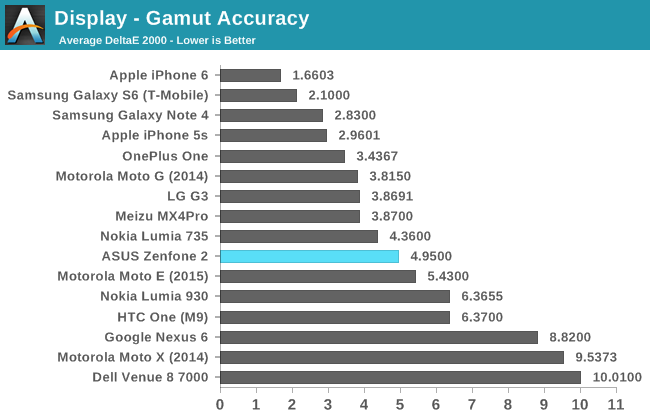The ASUS ZenFone 2 Preview
by Brandon Chester on May 18, 2015 2:00 PM ESTDisplay
I thought it would be important to give potential buyers some idea of how good the display is on the ZenFone 2. On paper it looks very good, as it's a 5.5" 1920x1080 IPS display. The pixel density isn't as high as the latest generation of 2560x1440 panels, but I find that with an RGB stripe panel the difference between 1920x1080 and 2560x1440 is minimal even at 5.5".


The ZenFone 2 appears to be off to a good start. Black levels are very low among our LCDs, and the max brightness is somewhat low but not terrible by any means. I never had any issues when using the ZenFone 2 outside, although it was definitely not as comfortable as the Galaxy S6.

The slightly low max brightness and above average black level results put the ZenFone 2 right in the middle of our LCD devices when it comes to contrast ratio.
Unfortunately, these numbers are somewhat misleading. This is because the ZenFone 2 makes extremely heavy use of dynamic contrast and contect adaptive backlighting. I have never used another device with such dramatic shifts in backlight power. The best example I've found is when switching from an all black to all white screen at max brightness. While this is obviously an extreme case, it illustrates the behavior that is occuring very well. At the moment you switch to white, the brightness of the display is around 170 nits. Over the next few seconds, that brightness rapidly increases to the 390 nits you see in the results above. This is an enormous jump in brightness, and it's very easy to see with your own eyes.
One last thing I'd like to note about the brightness is that the 100% setting on the built in brightness slider is not actually the max brightness that the display is capable of. The max you can achieve using the slider in the Settings app is 319 nits, which is around 82% of the 390 nit result you can get using applications like Brightness Adjuster from Google Play.

The gamut results are unfortunately not as good as what we've seen from the latest generation of smartphones. The DeltaE for red, blue, and magenta are all just over three, while the remaining three colors are around five. The high error in white also contributes to the higher than optimal overall error.
The complete review of the ZenFone 2 should be posted in the near future, and it will include the remainder of our display workflow. The heavy use of CABC and dynamic contrast has a large impact on the display's performance in some of our tests, and so I'll also be elaborating on where and why that occurs, and what it means for the user. For anyone who really wants to order the ZenFone 2 now, I'll conclude by saying that it's definitely not perfect, but it's still a good display. I think it's by far the nicest one you'll find on a phone that starts at $199 purely because of its resolution.











139 Comments
View All Comments
Brandon Chester - Monday, May 18, 2015 - link
If you know of any apps that have issues please let me know. Apart from certain NDK apps there shouldn't be any problems. None of the apps I use regularly had issues on this or the venue 8 7000.Shinshin - Tuesday, May 19, 2015 - link
I don't have any certain apps but I read a while ago this report:http://www.theregister.co.uk/2014/05/02/arm_test_r...
If you could somehow replicate the tests it would be awesome.
Thanks!
Gondalf - Monday, May 18, 2015 - link
This is wrong :). Only the cheaper Zenfone will sports a slow and dirty cheap 6xx SOC from Qualcomm. Other Zenfones will have Intel SOCs inside.Brandon Chester - Monday, May 18, 2015 - link
This is what I've heard as well, and the move to s615 for some lower end devices is not actually confirmed from what I understand.Shinshin - Tuesday, May 19, 2015 - link
Thanks to you too!blzd - Thursday, May 21, 2015 - link
Funny since Intel is practically giving away these SoCs. They're that desperate to get any design wins.BMNify - Monday, May 18, 2015 - link
Wrong/misleading information about Intel SOC, Asus will mostly use Mediatek SOCs in their future low-end devices which will cost $100-$150, the mid-range ($200-$300) will use intel SOC as usual.testbug00 - Tuesday, May 19, 2015 - link
that makes a lot more sense.bleh0 - Monday, May 18, 2015 - link
This phone is a definite buy for me. It could be smaller but I'll get used to it I guess.gijames1225 - Monday, May 18, 2015 - link
What networks/carriers is this going to support? Sounds like a great deal so far.